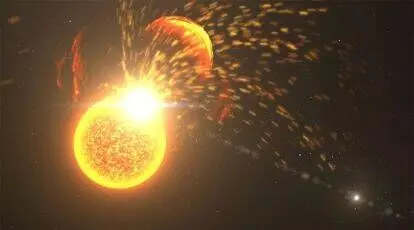
Life on Earth may have been brought about by extremely intense solar flares
text_fields“And was it a lightning storm that gave birth to the Earth,” sang American rapper Nas in his popular 2010 song Patience (Sabali). Lightning may not have created Earth, but it may have been the beginning of life on the planet, according to experts. However, a new hypothesis has recently been put forth that contends life originated as a result of solar explosions.
Scientists attempt to explain the formation of amino acids in order to comprehend how life first developed. Proteins and all biological life are made up of amino acids as their basic building blocks.
Scientific American claims that Charles Darwin was hesitant to share his ideas regarding the genesis of life. His views on the matter are only known through a letter he wrote to his friend and fellow employee Joseph Hooker.
“But if (& oh what a big if) we could conceive in some warm little pond with all sorts of ammonia & phosphoric salts,—light, heat, electricity &c present, that a protein compound was chemically formed, ready to undergo still more complex changes, at the present day such matter would be instantly devoured, or absorbed, which would not have been the case before living creatures were formed,” wrote Darwin in the letter sent in 1871.
Since then, scientists have proposed other theories, including the idea that life originated from lightning or developed in volcano pools. However, a study that was published in the journal Life suggests that solar particles can create amino acids and carboxylic acids, which are the fundamental components of proteins and organic life when they collide with Earth's early atmosphere.
The long and convoluted path to finding the origin of life
A significant step forward in the investigation of the beginning of life was made by the renowned Miller-Urey experiment in 1953. In the laboratory, Stanley Miller of the University of Chicago endeavoured to mimic the circumstances of the early Earth. He created a closed chamber by adding molecular hydrogen, ammonia, methane, and water to it. He then repeatedly fired an electrical spark to create the appearance of lightning.
These were the gases assumed to have been common in the early Earth's atmosphere. Harold Urey, Miller's graduate advisor, examined the chamber's contents a week after it was shut down and discovered that 20 distinct amino acids were produced.
“That was a big revelation. From the basic components of early Earth’s atmosphere, you can synthesize these complex organic molecules", said Vladimir Airapetian, co-author of the new paper in Life, in a press statement, referring to the Miller-Urey experiment. Stellar astronomer Airapetian by ll ulho works for NASA at the Goddard Space Flight Centre in Maryland.
But the conclusions that can be derived from the experiment have been obscured in the 70 years since it was conducted. According to NASA, scientists currently think that methane (CH4) and ammonia (NH3) were far less prevalent during Earth's early history. It included more molecular nitrogen and carbon dioxide, which are far more difficult to decompose.
These gases still have the ability to produce amino acids, but only in smaller amounts.
In an effort to find additional sources of energy that might have fueled the breakdown of those molecules. Some suggested that the source might be the shockwaves from approaching meteorites, while others mentioned ultraviolet rays. Data from NASA's Kepler mission were examined by Airapetian and colleagues in order to examine energy particles coming from the Sun, which is in a different direction.
Getting the Sun in the warm pond
In a paper published in Nature Geoscience in 2016, Airapetian claimed that during the first 100 million years of Earth's existence, the Sun was around 30% fainter but experienced frequent eruptions of massive "solar superflares." Super-powerful solar explosions called solar flares only occur around once per hundred years. The study found that when our planet was younger, it might have occurred once every three to ten days.
“As soon as I published that paper, the team from the Yokohama National University from Japan contacted me,” said Airapetian.
According to NASA, Kobayashi, a professor of chemistry at the Yokohama National University, was trying to understand how galactic cosmic rays could have affected the atmosphere of Early Earth.
“Most investigators ignore galactic cosmic rays because they require specialised equipment, like particle accelerators. I was fortunate enough to have access to several of them near our facilities,” said Kobayashi, in a press statement. Kobayashi studied prebiotic chemistry for more than 30 years, and by making minor adjustments to his setup, the researchers were able to test fresh hypotheses.
Similar to the Miller-Urey experiment, Airapetian, Kobayashi, and other researchers carried out their own study. They mixed water, molecular nitrogen, carbon dioxide, and varying amounts of methane. Then, to mimic solar particles, they fired a stream of protons into the mixture. In order to compare their results with the Miller-Urey experiment, they also fired these combinations with spark discharges.
As long as there was more than 5% methane in the mixture, detectable levels of amino acids and carboxylic acids appeared to be produced. Howeqver, the lightning-simulating spark discharges needed a 15% methane concentration before any amino acids could be produced. And even at 15% methane, the production rate of the amino acids by lightning is a million times less than by protons,” added.
The mixes launched by protons (solar particles) produced measurable levels of amino acids and carboxylic acids as long as the methane fraction was over 0.5%. But before any amino acids could develop, the lightning's spark discharges needed a methane concentration of roughly 15%.
“And even at 15% methane, the production rate of the amino acids by lightning is a million times less than by protons,” Airapetian added.
According to the research, solar particles appear to be a more effective energy source than lightning. However, Airapetian asserts that the odds are actually significantly better in favour of solar superflares. Thunderclouds, which are produced by heated air ascending, provide lighting. When the Sun was 30% darker, this would have been considerably less likely.























